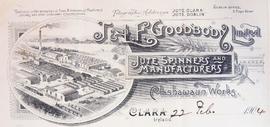Edenderry’s Poor Law Union was formed on the 7th of May in 1839. The Union was controlled by twenty-two elected Board of Guardians, as well as seven ex-officio Guardians, who all met weekly. It covered an area of 172,410 acres, representing electoral divisions from three different counties: from Offaly (King’s) – Ballaghassan, Ballyburly, Ballymacwilliam, Bracknagh, Clonbullogue, Clonmore, Clonsast, Croghan, Edenderry, Esker, Knockdrin and Monasteroris. From County Kildare – Ballynadrummy, Cadamstown, Carbury, Carrick, Cloncurry, Drehid, Dunfierth, Killinthomas, Kilpatrick, Kilrainy, Lullymore, Rathangan, Thomastown and Windmill Cross. From County Meath – Ardnamullen, Ballyboggan, Castlejordan, and the Hill of Down.
Edenderry workhouse, designed to accommodate 600 people, was completed in 1841 and took in its first residents in 1842. While the workhouse closed in 1921, the administrative structures of Edenderry Union were abolished in 1925, with the Board of Guardians powers being formally transferred to the county council’s Board of Health. The workhouse building itself had various uses in the following decades before being levelled in 1976 to make way for a home for the aged ‘Ofalia House’.

